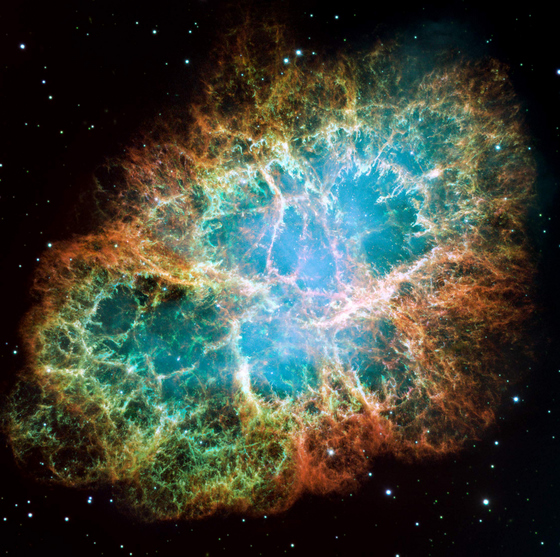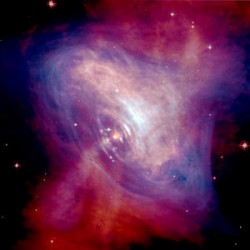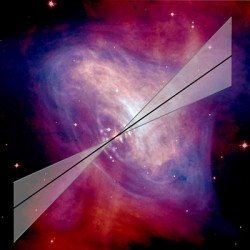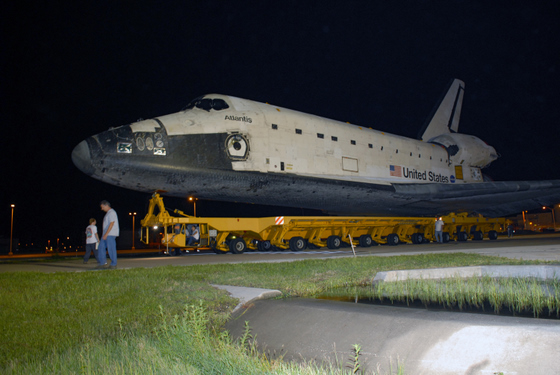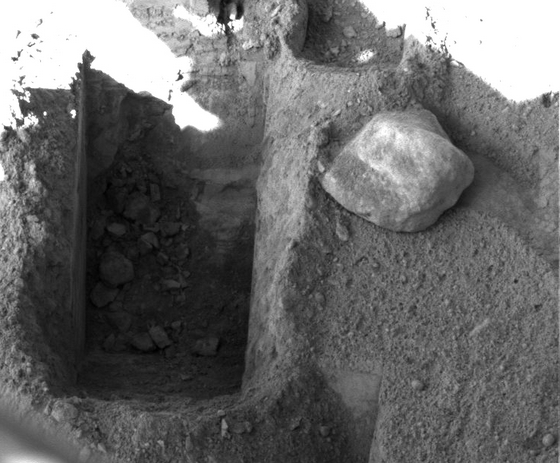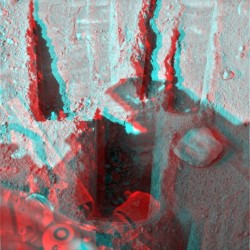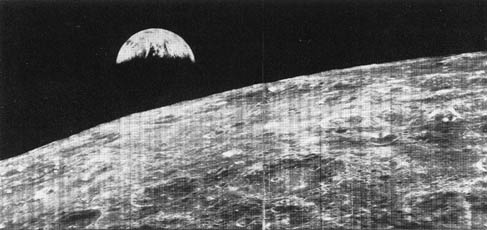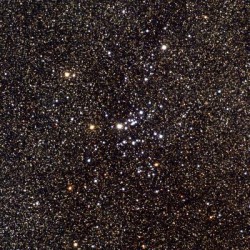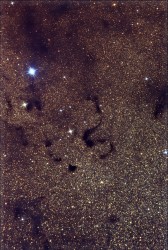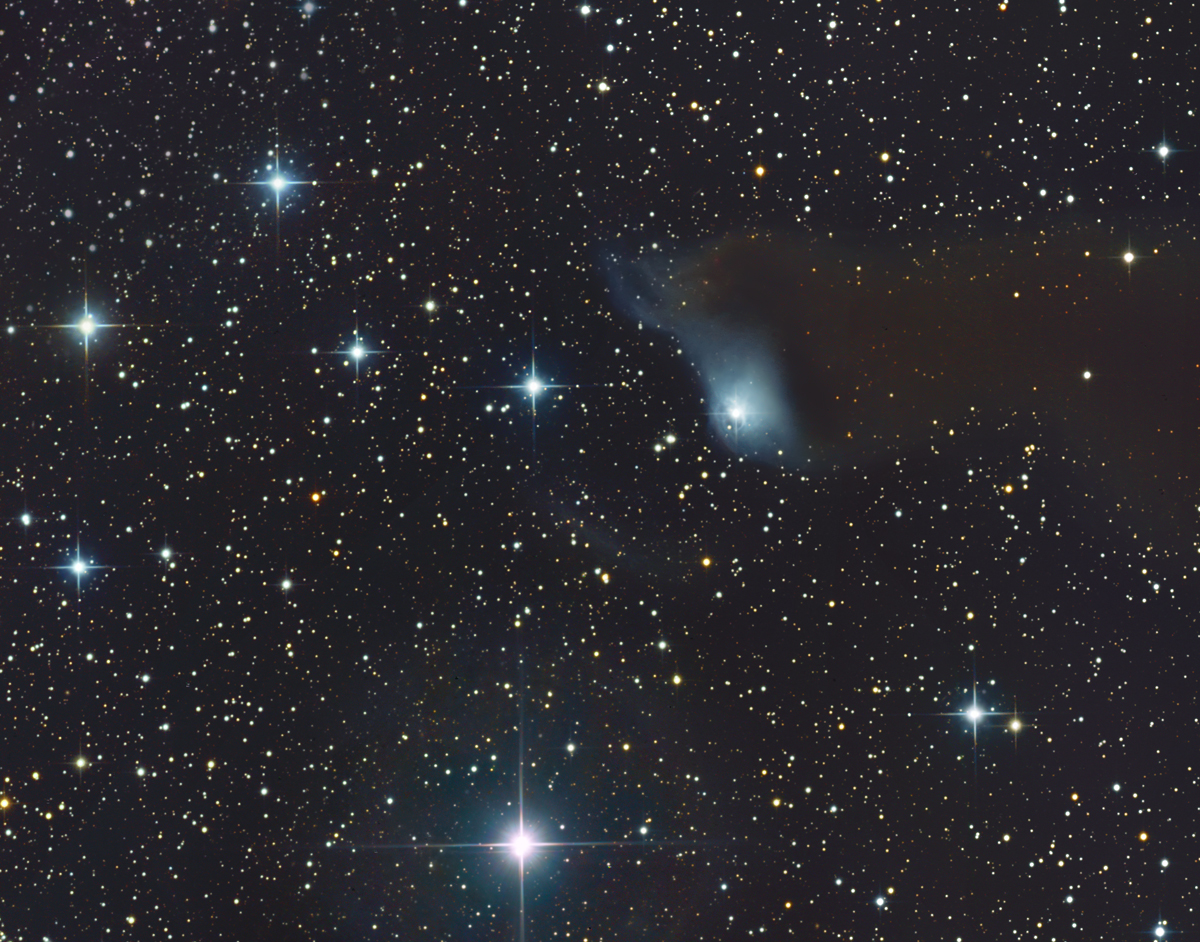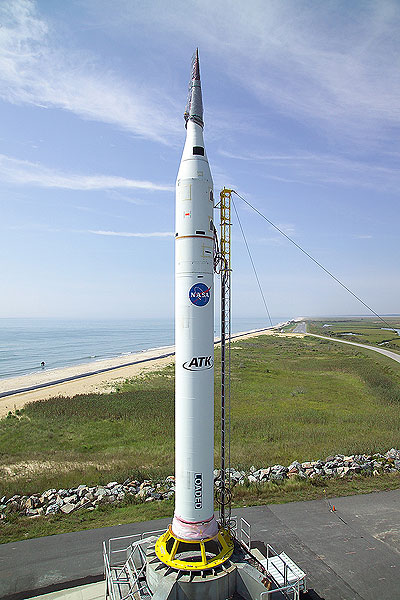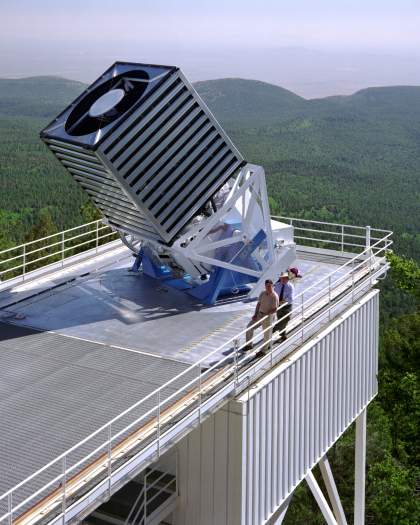Greetings, fellow SkyWatchers… It’s New Moon weekend and what better way to celebrate than to fly with the Swan and the Eagle?! While we’re out, we’ll drop by the Trifid, check into this week’s upcoming meteor shower activity and take a challenging walk into the world of dark nebula. Are you ready? Then it’s time to head out into the night… Together.
Friday, August 29, 2008 – While we’ve got a great dark skies night on our hands, it’s a perfect opportunity for all optics to hunt down a star forming region about a palm’s width north of the lid star (Lambda) in the Sagittarius teapot as we seek out the “Omega”…
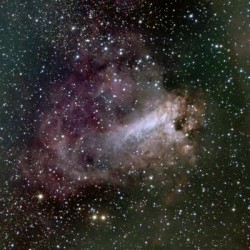 Easily viewed in binoculars of any size and outstanding in every telescope, the 5000 light-year distant Omega Nebula was discovered by Philippe Loys de Chéseaux in 1745-46 and later (1764) cataloged by Messier as object 17 (RA 18 20 26 Dec -16 10 36). This beautiful emission nebula is the product of hot gases excited by the radiation of newly born stars. As part of a vast region of interstellar matter, many of its embedded stars don’t show up in photographs, but reveal themselves beautifully to the eye at the telescope. As you look at its unique shape, you realize many of these areas are obscured by dark dust, and this same dust is often illuminated by the stars themselves.
Easily viewed in binoculars of any size and outstanding in every telescope, the 5000 light-year distant Omega Nebula was discovered by Philippe Loys de Chéseaux in 1745-46 and later (1764) cataloged by Messier as object 17 (RA 18 20 26 Dec -16 10 36). This beautiful emission nebula is the product of hot gases excited by the radiation of newly born stars. As part of a vast region of interstellar matter, many of its embedded stars don’t show up in photographs, but reveal themselves beautifully to the eye at the telescope. As you look at its unique shape, you realize many of these areas are obscured by dark dust, and this same dust is often illuminated by the stars themselves.
Often known as “The Swan,” M17 will appear as a huge, glowing check mark or ghostly “2” in the sky – but power up if you use a larger telescope and look for a long, bright streak across its northern edge with extensions to both the east and north. While the illuminating stars are truly hidden, you will see many glittering points in the structure itself and at least 35 of them are true members of this region, which spans up to 40 light-years and could form up to 800 solar masses. It is awesome…
Now let’s continue our nebula hunt as we head about a fingerwidth north and just slightly west of M8 for the “Trifid”…
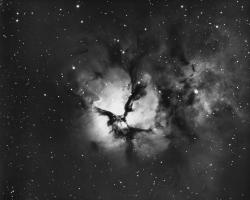 M20 (RA 18 02 23 Dec -23 01 48) was discovered by Messier on June 5, 1764; much to his credit he described it as a cluster of stars encased in nebulosity. This is truly a wonderful observation since the Trifid could not have been easy given his equipment. Some 20 years later William Herschel (although he tried to avoid repeating Messier objects) found M20 of enough interest to assign separate designations to parts of this nebula – IV.41, V.10, V.11, and V.12. The word “Trifid” was first used by John Herschel to describe its beauty.
M20 (RA 18 02 23 Dec -23 01 48) was discovered by Messier on June 5, 1764; much to his credit he described it as a cluster of stars encased in nebulosity. This is truly a wonderful observation since the Trifid could not have been easy given his equipment. Some 20 years later William Herschel (although he tried to avoid repeating Messier objects) found M20 of enough interest to assign separate designations to parts of this nebula – IV.41, V.10, V.11, and V.12. The word “Trifid” was first used by John Herschel to describe its beauty.
While M20 is a very tough call in binoculars, it is not impossible with good conditions to see light from an area which left its home nearly a millennium ago. Even smaller scopes will pick up the round, hazy patch of both emission and reflection, but you will need aversion to see the dark nebula which divides it; this was cataloged by Barnard as B 85. Larger telescopes will find the Trifid as one of the very few objects that actually appears much in the eyepiece as it does in photographs – with each lobe containing beautiful details, rifts and folds best seen at lower powers. Look for its cruciform star cluster and its fueling multiple star system while you enjoy this triple treat tonight!
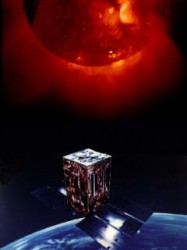 Saturday, August 30, 2008 – Today (in 1991) celebrates Yohkoh. The Yohkoh Mission was a joint effort of both Japan and the United States to launch a satellite to monitor the Sun’s corona and study solar flares. While the mission was quite successful, on December 14, 2001, the spacecraft’s signal was lost during a total eclipse. Controllers were unable to point the satellite back toward the Sun, so its batteries discharged and Yohkoh became inoperable.
Saturday, August 30, 2008 – Today (in 1991) celebrates Yohkoh. The Yohkoh Mission was a joint effort of both Japan and the United States to launch a satellite to monitor the Sun’s corona and study solar flares. While the mission was quite successful, on December 14, 2001, the spacecraft’s signal was lost during a total eclipse. Controllers were unable to point the satellite back toward the Sun, so its batteries discharged and Yohkoh became inoperable.
Tonight is New Moon and while the darkest skies are on our side, we’ll fly with the “Eagle” as we hop another fingerwidth north of M17 to M16 (RA 18 18 48 Dec -13 49 00) and head for one of the most famous areas of starbirth, IC 4703…
 While the open cluster NGC 6611 was discovered by Chéseaux in 1745-6, it was Charles Messier who cataloged the object as M16. And he was the first to note the nearby nebula IC 4703, now commonly known as the Eagle. At 7000 light-years distant, this roughly 7th magnitude cluster and nebula can be spotted in binoculars, but at best it is only a hint. As part of the same giant cloud of gas and dust as neighboring M17, the Eagle is also a place of starbirth illuminated by these hot, high energy stellar youngsters which are only about five and a half million years old.
While the open cluster NGC 6611 was discovered by Chéseaux in 1745-6, it was Charles Messier who cataloged the object as M16. And he was the first to note the nearby nebula IC 4703, now commonly known as the Eagle. At 7000 light-years distant, this roughly 7th magnitude cluster and nebula can be spotted in binoculars, but at best it is only a hint. As part of the same giant cloud of gas and dust as neighboring M17, the Eagle is also a place of starbirth illuminated by these hot, high energy stellar youngsters which are only about five and a half million years old.
In small to mid-sized telescopes, the cluster of around 20 brighter stars comes alive with a faint nebulosity that tends to be brighter in three areas. For larger telescopes, low power is essential. With good conditions, it is very possible to see areas of dark obscuration and the wonderful notch where the “Pillars of Creation” are located. Immortalized by the Hubble Space telescope, they won’t be nearly as grand or as colorful as the HST saw them, but what a thrill to know they are there!
Sunday, August 31 – Tonight we will begin entering the stream of the Andromedid meteor shower, which peaks off and on for the next couple of months. For those of you in the northern hemisphere, look for the lazy “W” of Cassiopeia to the northeast. This is the radiant – or relative point of origin – for this meteor stream. At times, this shower has been known to be spectacular, but let’s stick with an accepted fall rate of around 20 per hour. These are the offspring of Biela’s Comet, one that split apart in 1846 leaving radically different streams – much like 73/P Schwassman-Wachmann in 2006. These meteors have a reputation for red fireballs with spectacular trains, so watch for them in the weeks ahead.
While there’s still no Moon to interfere with the dark – let’s take another, more challenging, look at the “dark” as we head toward open cluster NGC 6520…
Located just slightly more than a fingerwidth above Gamma Sagittarii and 5500 light-years away, NGC 6520 (RA 18 03 24 Dec –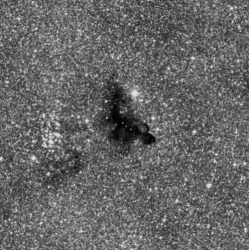 27 53 00) is a galactic star cluster which formed millions of years ago. Its blue stars are far younger than our own Sun, and may very well have formed from what you don’t see nearby – a dark, molecular cloud. Filled with dust, Barnard 86 literally blocks the starlight coming from our galaxy’s own halo area in the direction of the core. To get a good idea of just how much light is blocked by B 86, take a look at the star SAO 180161 on the edge. Behind this obscuration lies the densest part of our Milky Way! This one is so dark that it’s often referred to as the “Ink Spot.”
27 53 00) is a galactic star cluster which formed millions of years ago. Its blue stars are far younger than our own Sun, and may very well have formed from what you don’t see nearby – a dark, molecular cloud. Filled with dust, Barnard 86 literally blocks the starlight coming from our galaxy’s own halo area in the direction of the core. To get a good idea of just how much light is blocked by B 86, take a look at the star SAO 180161 on the edge. Behind this obscuration lies the densest part of our Milky Way! This one is so dark that it’s often referred to as the “Ink Spot.”
While both NGC 6520 and B 86 are about the same distance away, they don’t reside in the hub of our galaxy, but in the Sagittarius Spiral Arm. Seen in binoculars as a small area of compression, and delightfully resolved in a telescope, you’ll find this cluster is on the Herschel “400” list and many others as well. Enjoy this rare pair tonight!
This week’s awesome images are: M17 – Credit: Hillary Mathis, N.A.Sharp, REU program/NOAO/AURA/NSF, M20 – NOAO/AURA/NSF, Yohkoh – Credit: NASA, M16 – Credit: Bill Schoening/NOAO/AURA/NSF and NGC 6520 and B 86 – Credit: Palomar Observatory, courtesy of Caltech. Thank you!!


